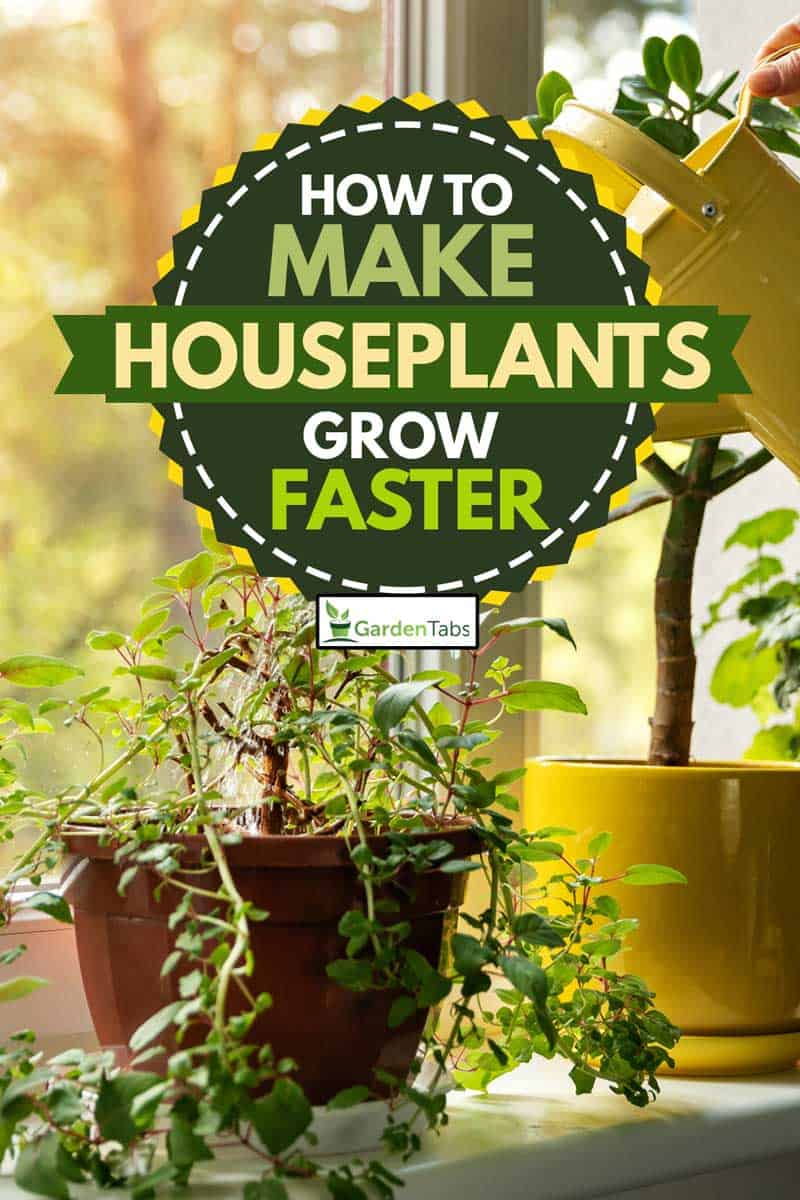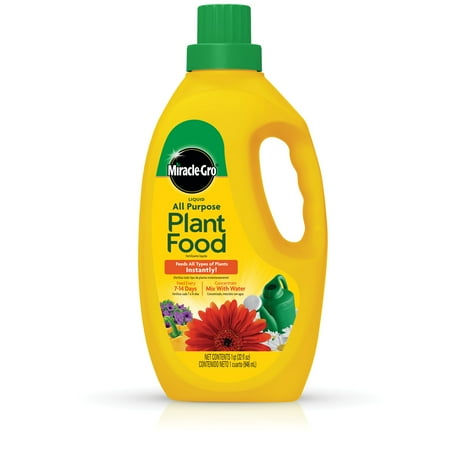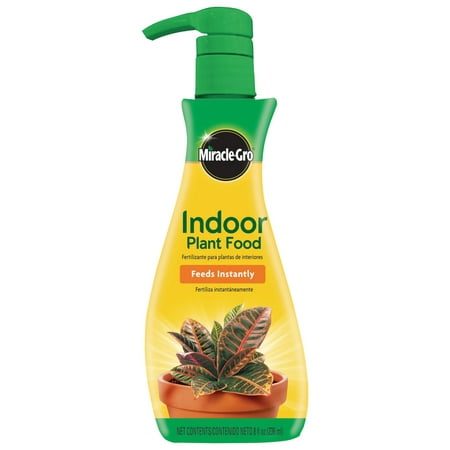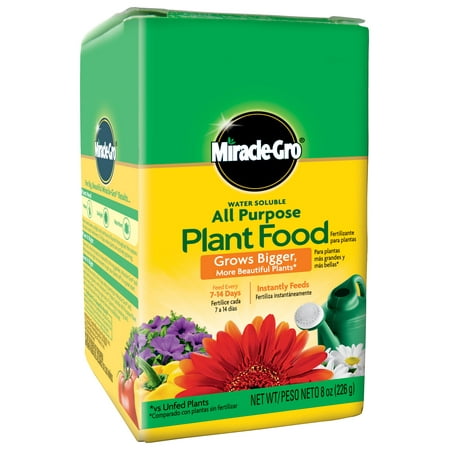Houseplants enliven any room of your home. Locate your indoor plants in their ideal environment, then consider how to make houseplants grow faster. We’ve researched what makes houseplants flourish to get the answer for you.
You can help your houseplants grow faster by adding essential nutrients to the potting soil with either an organic or inorganic fertilizer.

Plants are relatively self-sufficient if provided light, water, and preferred climate. But, your houseplants will excel when fed the right nutrients. Keep reading, and we’ll discuss different types of fertilizers for houseplants and growing tips for plants to thrive.
What Liquid Will Make Plants Grow Faster?
Liquid fertilizers are fast-acting, to feed plants ample nutrients with each application. Dilute liquid fertilizers with water, and apply during your regular watering routine.
Inorganic Liquid Fertilizers
It is easy to over-fertilize houseplants with inorganic liquid fertilizers because they contain a highly concentrated dose of nutrients. Read the instructions carefully, and lower the amount if necessary.
Miracle-Gro All-Purpose Concentrate
Miracle-Gro’s liquid, all-purpose formula is robust so that you will see bigger, brighter results immediately. We recommend using half a dose of this 12-4-8 (nitrogen, phosphorus, and potassium) concentration on houseplants.
Click here to find this at Walmart.
Miracle-Gro Indoor Plant Food
Formulated for fast results, Miracle-Gro has toned down the strength of this 1-1-1 (nitrogen, phosphorus, and potassium) fertilizer to be just right for houseplants.
Click here to find this at Walmart.
Organic Liquid Fertilizers
Concentrated from composted material, organic liquid fertilizers tend to have lower doses of nitrogen, phosphorous, and potassium, so over-fertilizing houseplants is less risky. Follow the instructions provided.
Fox Farm
Choose the right organic formula for your indoor potted plants with Fox Farm’s trio. Feed houseplants to produce either big blooms, lush foliage, or hardy herbs.
Click here to find this on Amazon.
Neptune’s Harvest
All-purpose, fish and seaweed fertilizer feeds houseplants a hardy dose of 2-4-1 (nitrogen, phosphorous, and potassium). Additional micronutrients found in fish compost, like calcium, keep plants healthy.
Click here to find this on Amazon.
What Can You Put in Soil to Make Plants Grow Faster?
Add water-soluble, granular fertilizers to the soil to nourish houseplants. Simply sprinkle around the base of the plant and then water. Always follow the instructions provided.
Inorganic Granular Fertilizers
Using an inorganic granular fertilizer means that you can choose nutrients that are either specific to your houseplants’ needs, or all-purpose for fast-growing results.
Miracle-Gro All-Purpose
Miracle-Gro’s All-Purpose granular formula is packed full of nutrients with 24-8-16 (nitrogen, phosphorous, and potassium). Jumpstart growth for your houseplants, and then promote ongoing blooms or brilliant foliage throughout the year with Miracle-Gro.
Click here to find this at Walmart.
Osmocote Slow Release Plant Food
Specially formulated for indoor and outdoor potted plants, Osmocote’s slow-release formula means you can fertilize once every six-months. Plants are fed during each watering cycle by slow-release granules providing 11 essential nutrients.
Click here to find this on Amazon.
Organic Composted Fertilizers
Going organic means you might not know the specific nutrient content of the fertilizer, but you will achieve healthier soil by adding macro and micronutrients. Organic composted fertilizers are 100% biodegradable and safe to use near children and pets.
Joyful Dirt
Easily apply soluble, Joyful Dirt Organic Fertilizer to houseplants either by sprinkling atop the potting soil or by mixing with water. This 8-1-5 formula contains nitrogen, phosphorous, and potash.
Click here to find this on Amazon.
Organic Plant Magic
Organic Plant Magic’s water-soluble formula can easily be incorporated into your watering routine. Simply add water to feed your plants 55 essential minerals, plus beneficial microorganisms.
Click here to find this on Amazon.
How Do You Make Houseplants Thrive?
Setting up the right environment is critical for houseplants to thrive. Try to choose a location first, and then select plants by matching their needs to the condition in that location.
Container Selection
Choose a container that is slightly larger than the roots of the plant. The right size container encourages growth, but too big a container risks root rot.
Ideally, the container should have drainage holes at the bottom and a water catchment dish. If there are no drainage holes, you can put a layer of pebbles on the bottom of the container to allow excess water to drain from the soil. The stones will keep excess water away from the plant’s roots to avoid rot.
Click here to find this on Amazon.
Having trouble finding the right container? Check out our blog, “4 Houseplants That Don’t Need Any Drainage [& How to Grow Any Plant With No Drainage]”
Soil Selection
Houseplants thrive in porous soil, like potting soil. Indoor potting mixes keep the roots aerated, yet moist.
Click here to find this on Amazon.
Watering Routine
Houseplants are typically happy when kept moist, although watering routines vary based on the type of plant. Flowering plants, for instance, require more water than foliage plants. Succulents need hardly any water at all.
Check the soil by touch and appearance. If soil is crumbly, cracked, or lighter in color, then it is probably time to water your houseplants. Water houseplants either from the top or from the bottom by allowing water to seep into the soil. Dump any standing water from catchment dishes within an hour after watering.
If you enjoy houseplants but are forgetful when it comes to watering, let a watering bulb to do the job for you. Decorative bulbs are easy to fill with water, then insert into potting soil. Watering bulbs will slowly dispense water for up to two weeks.
Click here to find this on Amazon.
Lighting
All plants need natural sunlight to thrive. If your plants require direct light, putting them near a window or in a sunroom is a good option. Shade dwelling plants might be happier in a room with indirect lighting. Supplement natural sunlight by using a grow light.
Click here to find this on Amazon.
Temperature & Humidity
The temperate climate in most homes is ideal for houseplants that thrive in temperature ranges between 55°F - 75°F. Be mindful of the location, to keep houseplants away from drafty areas and heat exhausts where temperatures might fluctuate throughout the day.
Houseplants typically prefer humid environments. In drier climates, or during the winter season, you might need to increase the humidity in your home by:
- Set houseplants atop a tray filled with pebbles and water.
- Mist the plant’s foliage daily.
- Group houseplants together.
- Run a humidifier in proximity to houseplants.
Click here to find this on Amazon.
Transform a humid bathroom into a tropical oasis. Check out our blog, “7 Hanging Plants That Can Grow Well in the Bathroom.”
Is Milk Good for Plants?
Nutrients in milk like calcium and vitamin B are beneficial to your plants. It is OK to add any type of milk to your garden; spoiled, raw, whole-fat, low-fat, evaporated, and powdered. Just make sure to dilute the milk with an equal portion of water. Microbes in the soil will do the work to break down milk’s larger molecules so your plants can more easily absorb them as food.
Is Sugar Water Good for Plants?
Feeding sugar water to plants is not beneficial because the sugar molecules inhibit the roots’ ability to absorb water. The soil will stay moist, and the remaining sugar will eventually be broken down by microorganisms. Too much sugar in the ground can lead to root rot or fungal infections and eventually could kill the plants.
Plants naturally produce their own sugar, or glucose, through the process of photosynthesis. Providing the right environmental and nutritional conditions for houseplants is the best way to ensure that plants will produce enough glucose naturally.
Is Coca Cola Good for Plants?
Coca Cola’s high sugar content, 39-grams in a 12-ounce can, is not suitable for your plants. If you want to feed your plants a soft drink, try using an unsweetened, carbonated drink like mineral water or club soda. These soft drinks have added nutrients like oxygen, carbon, nitrogen, sulfur, hydrogen, phosphorous, potassium, and sodium that can benefit growth without prohibitive sugar.
Are Coffee Grounds Good for Plants?
Either fresh or used, coffee grounds are an excellent source of nutrients for your plants. Coffee grounds contain three essential macronutrients that plants need to grow; nitrogen, phosphorus, and potassium. Additionally, coffee grounds are a good source of calcium.
Sprinkle dry, fresh grounds or moist used grounds onto the topsoil around the base of your houseplants. For your houseplant watering routine, use coffee-infused water by merely letting the grounds steep in the water overnight.
Do Plants Like Music?
Research has demonstrated that plants can hear, although they cannot necessarily distinguish between music and other sounds. Plants tune-in to the vibration of sounds, and this attentiveness is used to both stimulate growth and improve defenses. So, if you want to help your houseplants grow, playing any genre of music in the background is a good idea.
Now that you know all of the ways to make houseplants grow faster, you can enjoy lush, vibrant blooms and foliage throughout your home.













